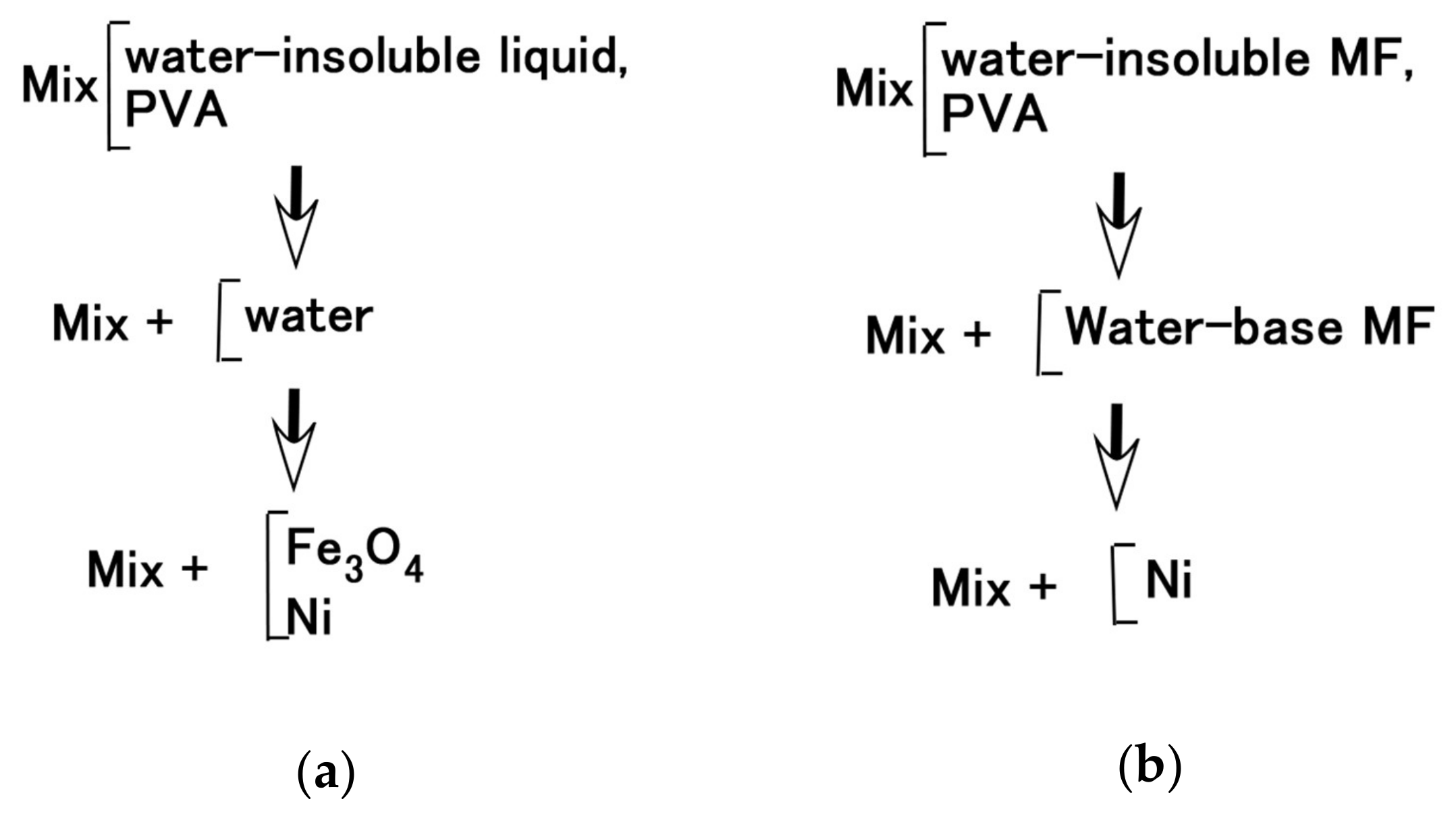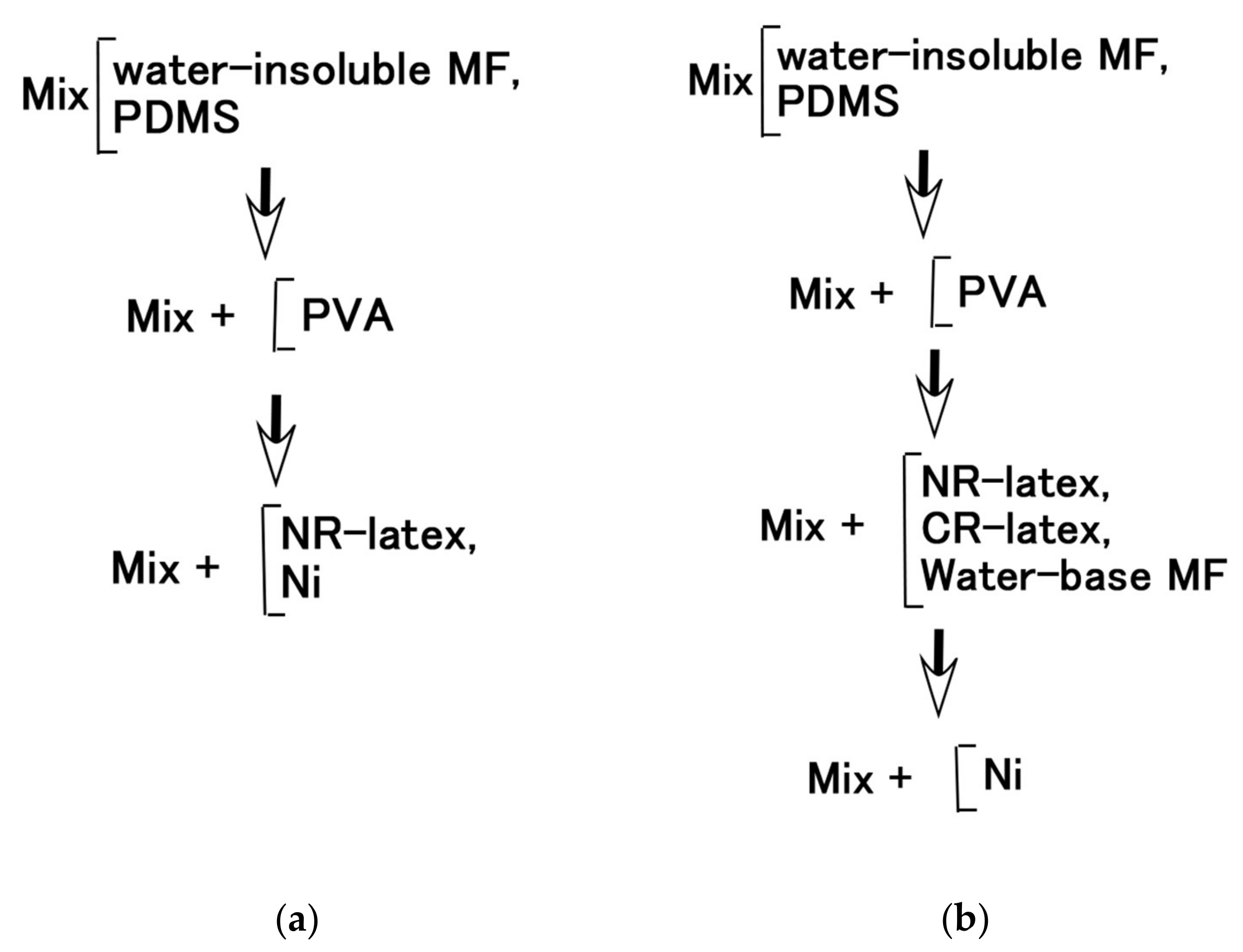Enhancement of Diversity in Production and Application Utilizing Electrolytically Polymerized Rubber Sensors with MCF: 1st Report on Consummate Fabrication Combining Varied Kinds of Constituents with Porous Permeant Stocking-Like Rubber
Abstract
1. Introduction
2. Electrolytic Polymerization
2.1. Rubber
2.2. Water-Insoluble Liquid and MF
2.3. Surfactant
3. Consummate Fabrication of MCF Rubber Sensor
3.1. Rubber Stocking
3.2. Consummate Fabrication
4. Conclusions
Author Contributions
Funding
Conflicts of Interest
Appendix A
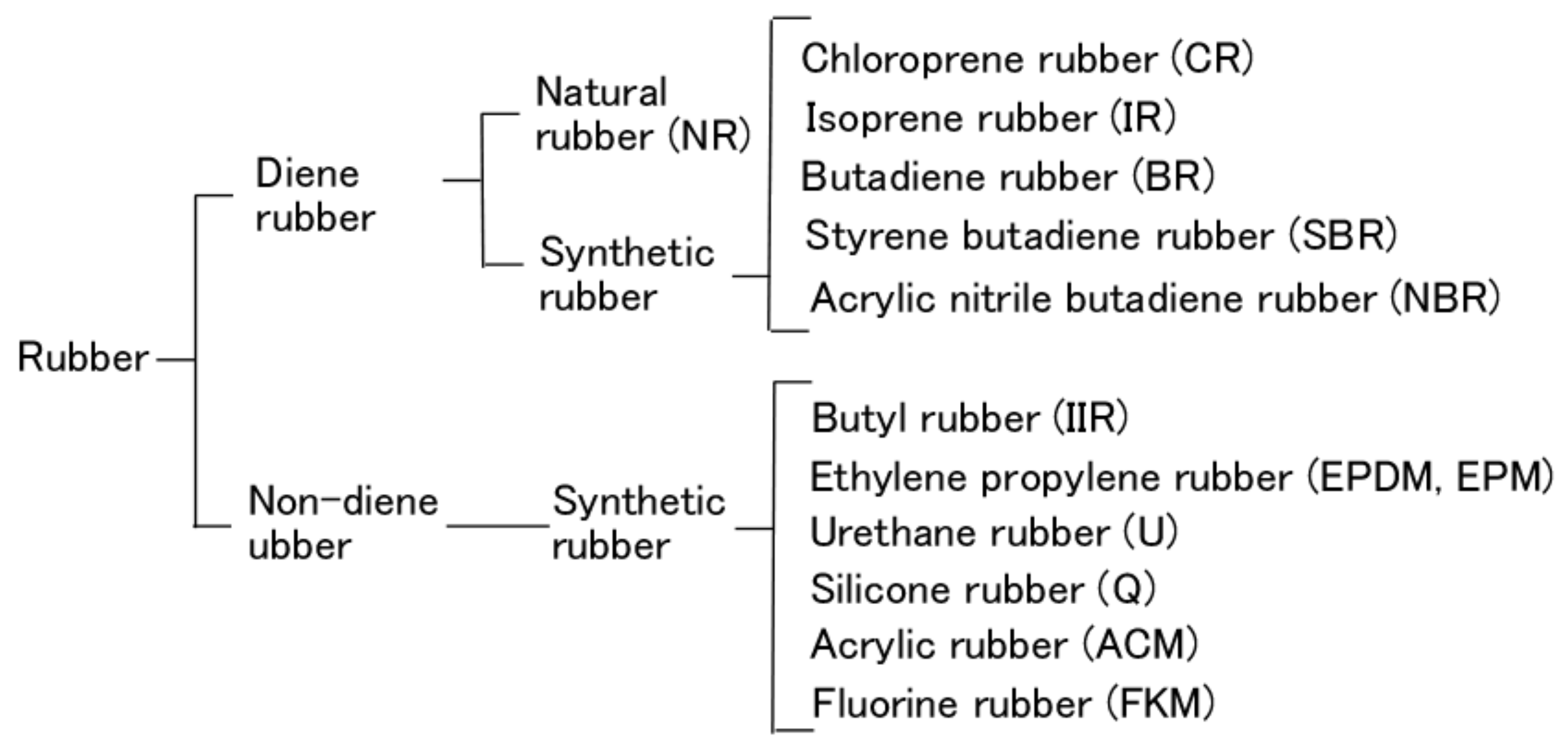
Appendix B
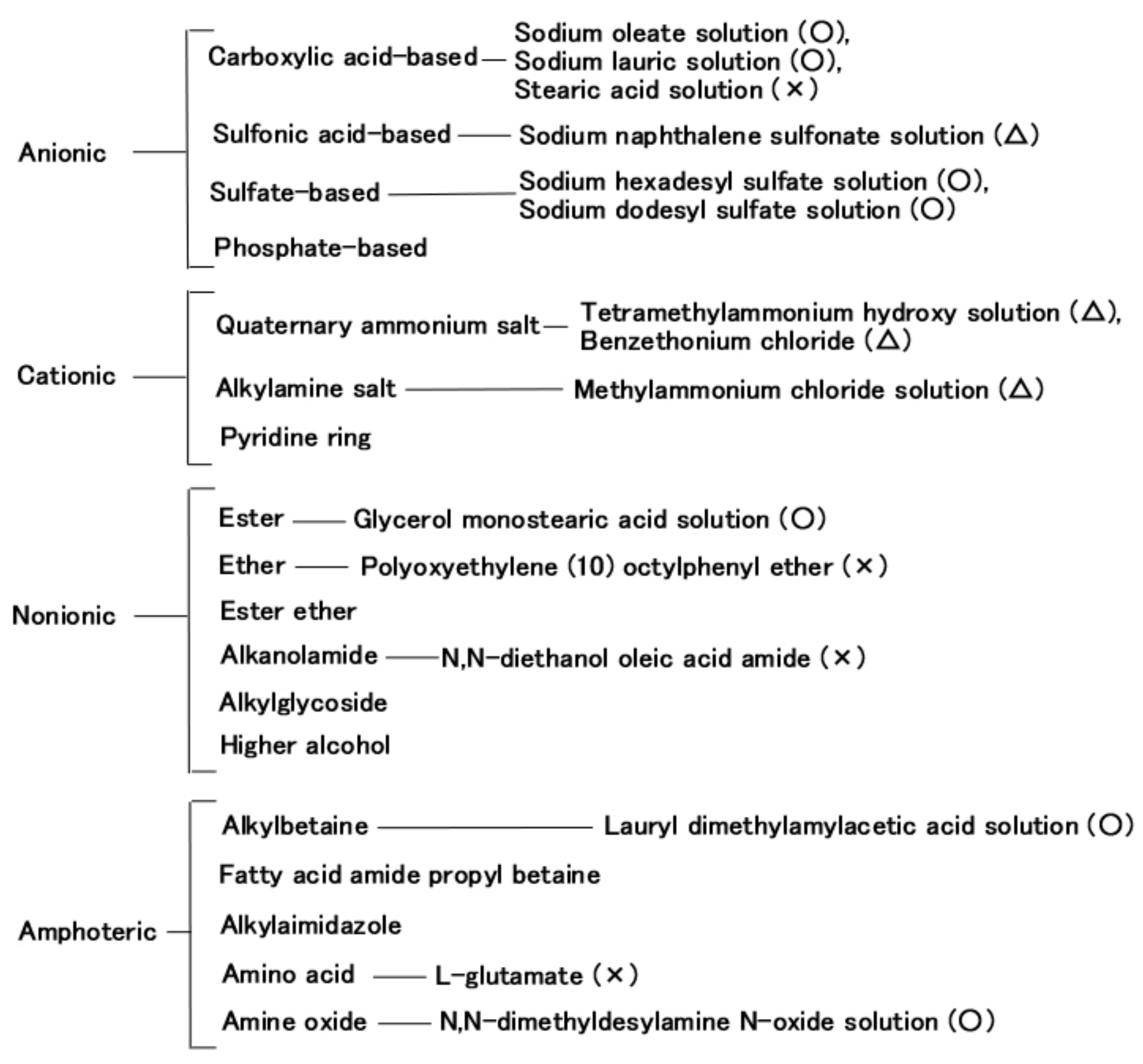
Appendix C
| MCF Rubber Type | Induced Voltage | Induced Electric Current | Electric Resistance | Dopant |
|---|---|---|---|---|
| Conductive type | Minimum (1-ordered mV) | Minimum (1-ordered µA) | Minimum (0.1, 1-ordered Ω) | KI, I2, Tetraethylammonium tetrafluoroborate |
| Piezo type | Large (10, 100-ordered mV) | Small (10-ordered µA) | Large (kΩ, MΩ) | TiO2, ZnO, BaTiO, Aluminum nitride, Lead(II) titanium(IV) trioxide, Potassium niobate, Lithium niobate |
| Battery type | Large (10, 100- ordered mV) | Large (100-ordered µA) | Large (kΩ, MΩ) | KOH, Lithium hydroxide monohydrate, Trilithium Citrate Tetrahydrate |
References
- Kawasaki, H.; Komatsu, T.; Uchiyama, K. Dexterous anthropomorphic robot hand with distributed tactile sensors: Gifu hand II. IEEE/ASME Trans. Mechatron. 2002, 7, 296–303. [Google Scholar] [CrossRef]
- Lee, H.K.; Chang, S.I.; Yoon, E. Dual-mode capacitive proximity sensor for robot application: Implementation of tactile and proximity sensing capability on a single polymer platform using shared electrodes. IEEE Sens. J. 2009, 9, 1748–1755. [Google Scholar] [CrossRef]
- Kimoto, A.; Sugitani, N.; Fujisaki, S. A multifunctional tactile sensor based on PVD films for identification of materials. IEEE Sens. J. 2010, 10, 1508–1513. [Google Scholar] [CrossRef]
- Yoshida, T. The Leading Edge of Development of Super Five Senses Sensor, 1st ed.; NTS Press: Tokyo, Japan, 2005; pp. 253–393. [Google Scholar]
- Hammock, M.L.; Chortos, A.; Tee, B.C.K.; Tok, J.B.H.; Bao, Z. 25th anniversary article: The evolution of electronic skin (E-Skin): A brief history, design considerations, and recent progress. Adv. Mater. 2013, 25, 5997–6038. [Google Scholar] [CrossRef]
- Shimada, K. Elastic MCF rubber with photovoltaics and sensing for use as artificial or hybrid skin (H-Skin): 1st report on dry-type solar cell rubber with piezoelectricity for compressive sensing. Sensors 2018, 18, 1841. [Google Scholar] [CrossRef]
- Shimada, K. Elastic MCF rubber with photovoltaics and sensing on hybrid skin (H-Skin) for artificial skin by utilizing natural rubber: 2nd report on effect of tension and compression on properties of hybrid photo- and piezo-electricity in wet-type solar cell rubber. Sensors 2018, 18, 1848. [Google Scholar] [CrossRef]
- Shimada, K. MCF rubber with photovoltaics and sensing for use as artificial or hybrid skin (H-Skin): Third report on electric charge and storage under tension and compression. Sensors 2018, 18, 1853. [Google Scholar] [CrossRef]
- Shimada, K.; Saga, N. Mechanical enhancement of sensitivity in natural rubber using electrolytic polymerization aided by a magnetic field and MCF for application in haptic sensors. Sensors 2016, 16, 1521. [Google Scholar] [CrossRef]
- Shimada, K.; Saga, N. Detailed mechanism and engineering applicability of electrolytic polymerization aided by a magnetic field in natural rubber by mechanical approach for sensing (Part 1): The effect of experimental conditions on electrolytic polymerization. World J. Mech. 2016, 6, 357–378. [Google Scholar] [CrossRef]
- Shimada, K.; Saga, N. Detailed mechanism and engineering applicability of electrolytic polymerization aided by a magnetic field in natural rubber by mechanical approach for sensing (Part 2): Other and intrinsic effects on MCF rubber property. World J. Mech. 2016, 6, 379–395. [Google Scholar] [CrossRef]
- Shimada, K. Enhancement of MCF rubber utilizing electric and magnetic fields, and clarification of electrolytic polymerization. Sensors 2017, 17, 767. [Google Scholar] [CrossRef] [PubMed]
- Shimada, K.; Shuchi, S.; Kanno, H.; Wu, Y.; Kamiyama, S. Magnetic cluster and its applications. J. Magn. Magn. Mater. 2005, 289, 9–12. [Google Scholar] [CrossRef]
- Shimada, K.; Kikura, H.; Takahashi, H.; Ikeda, R. Novel adhesion technique using metallic or non-metallic hydrous oxide of metal complexes involving magnetic compound fluid rubber under electrolytic polymerization and magnetic field for producing sensors. Sensors 2019, 19, 689. [Google Scholar] [CrossRef] [PubMed]
- Shimada, K.; Ikeda, R.; Takahashi, H.; Kikura, H. Development of a magnetic compound fluid rubber stability sensor and a novel production technique via combination of natural, chloroprene and silicone rubbers. Sensors 2019, 189, 3901. [Google Scholar] [CrossRef] [PubMed]
- Shokr, F.S. Electrical properties of conductive rubber blends subjected to solvent penetration. Plas. Rub. Compos. 2012, 41, 441–448. [Google Scholar] [CrossRef]
- Ma, L.F.; Bao, R.Y.; Dou, R.; Zheng, S.D.; Liu, Z.Y.; Zhang, R.Y.; Yang, M.B.; Yang, W. Conductive thermoplastic vulcanizates (TPVs) based on polypropylene (PP)/ethylene-propylene-diene rubber (EPDM) blend: From strainsensor to highly stretchable conductor. Compos. Sci. Tech. 2016, 128, 176–184. [Google Scholar] [CrossRef]
- Balasoiu, M.; Lebedev, V.T.; Orlova, D.N.; Bica, I. Magnetic field and particle concentration competitive effects on ferrofluid based silicone elastomer microstructure. Nanomat. Ceram. 2011, 56, 1177–1180. [Google Scholar] [CrossRef]
- Lefevre, V.; Danas, K.; Pamies, O.L. A general result for the magnetoelastic response of isotropic suspensions of iron and ferrofluid particles in rubber, with applications to spherical and cylindrical specimens. J. Mech. Phys. Solids 2017, 107, 343–364. [Google Scholar] [CrossRef]
- Yoshimura, K.; Nakano, K.; Hishikawa, Y. Flexible tactile sensor materials based on carbon microcoil/silicone-rubber porous composites. Compos. Sci. Tech. 2016, 123, 214. [Google Scholar] [CrossRef]
- Franesqui, M.A.; Yepes, J.; García-González, C.; Gallego, J. Sustainable low-temperature asphalt mixtures with marginal porousvolcanic aggregates and crumb rubber modified bitumen. J. Clean. Prod. 2019, 207, 44. [Google Scholar] [CrossRef]
- Kawano, A.; Yamamoto, K.; Kadokawa, J. Preparation of self-assembled chitin nanofiber-natural rubber composite sheets and porous materials. Biomolecules 2017, 7, 47. [Google Scholar] [CrossRef] [PubMed]
- Hassan, H.K.; Oraimi, S.A.; Taha, R.T. Evaluation of open-graded friction course mixtures containing cellulose fibers and styrene butadiene rubber polymer. J. Mat. Civil Eng. 2005, 17, 416. [Google Scholar] [CrossRef]
- Shimada, K.; Ikeda, R.; Kikura, H.; Takahashi, H. Enhancement of diversity in production and application utilizing electrolytically polymerized rubber sensors with MCF: 2nd report on various engineering applications. Sensors 2020. to be submitted. [Google Scholar]
- Shimada, K.; Saga, N. Development of a hybrid piezo natural rubber piezoelectricity and piezoresistivity sensor with magnetic clusters made by electric and magnetic field assistance and filling with magnetic compound fluid. Sensors 2017, 17, 1521. [Google Scholar] [CrossRef]
- Toko, K.; Hara, D.; Tahara, Y.; Yasduura, M.; Ikezaki, H. Relationship between the amount of bitter substances adsorbed onto lipid/polymer membrane and the electric response of taste sensors. Sensors 2014, 14, 16274. [Google Scholar] [CrossRef]
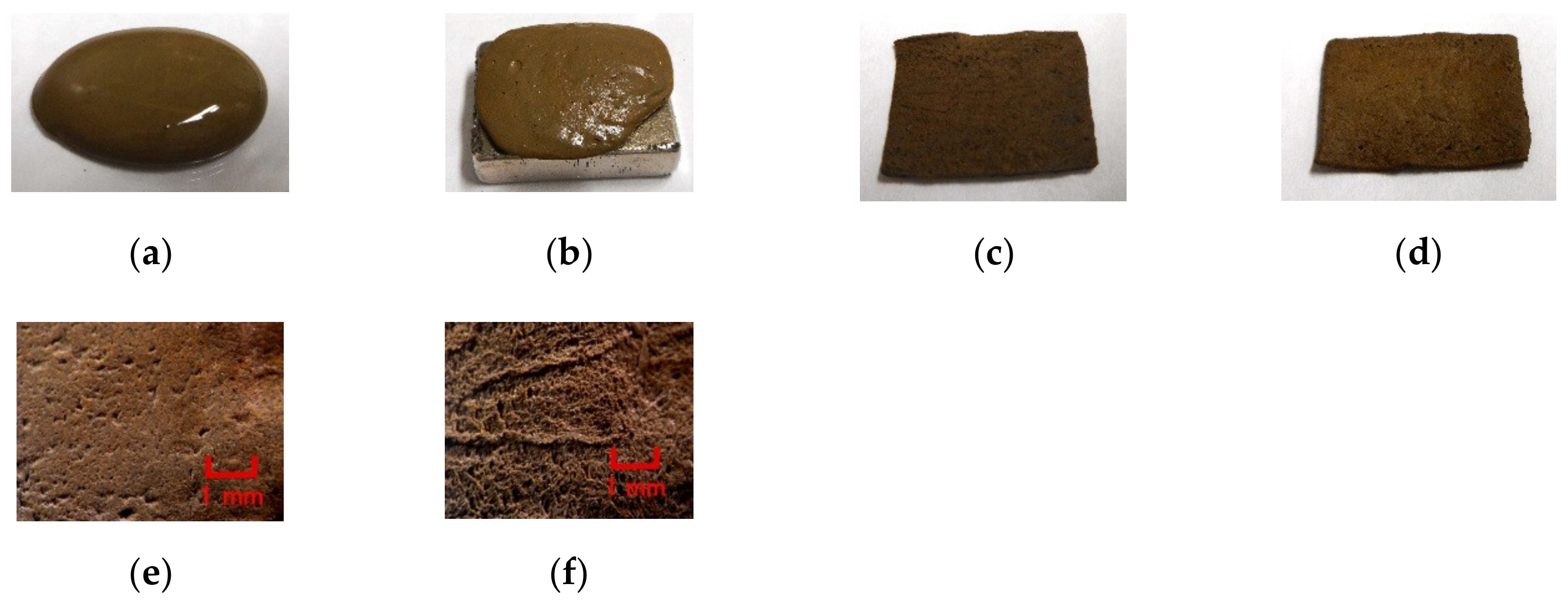
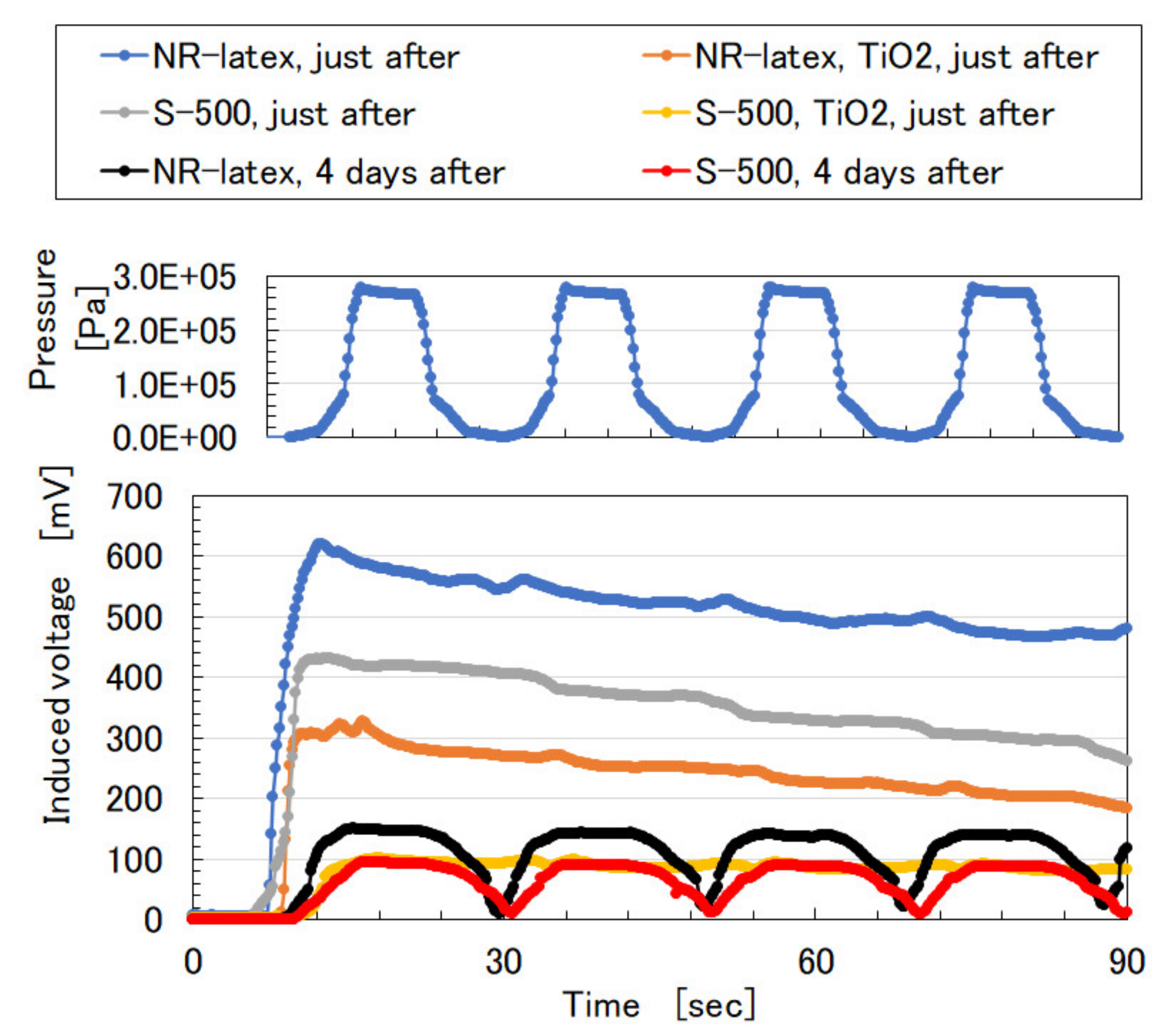
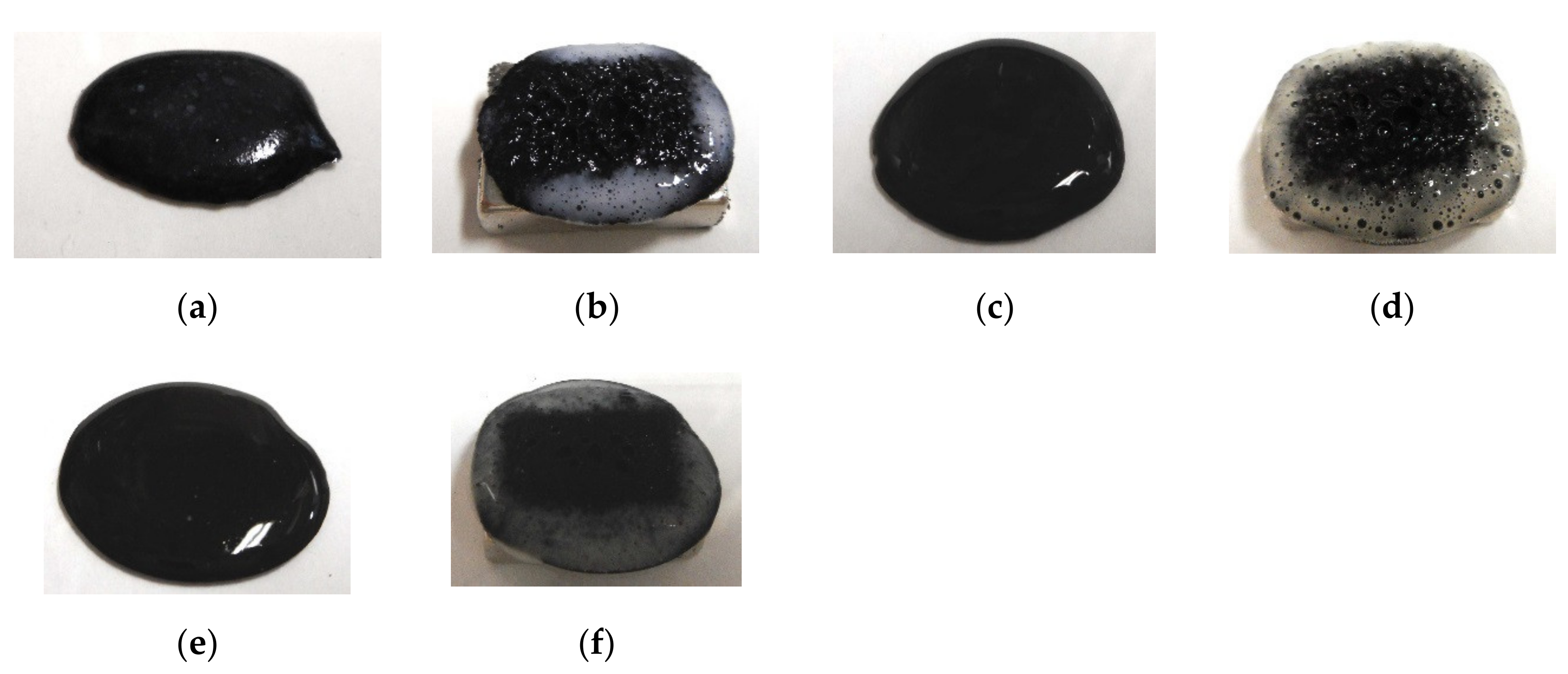

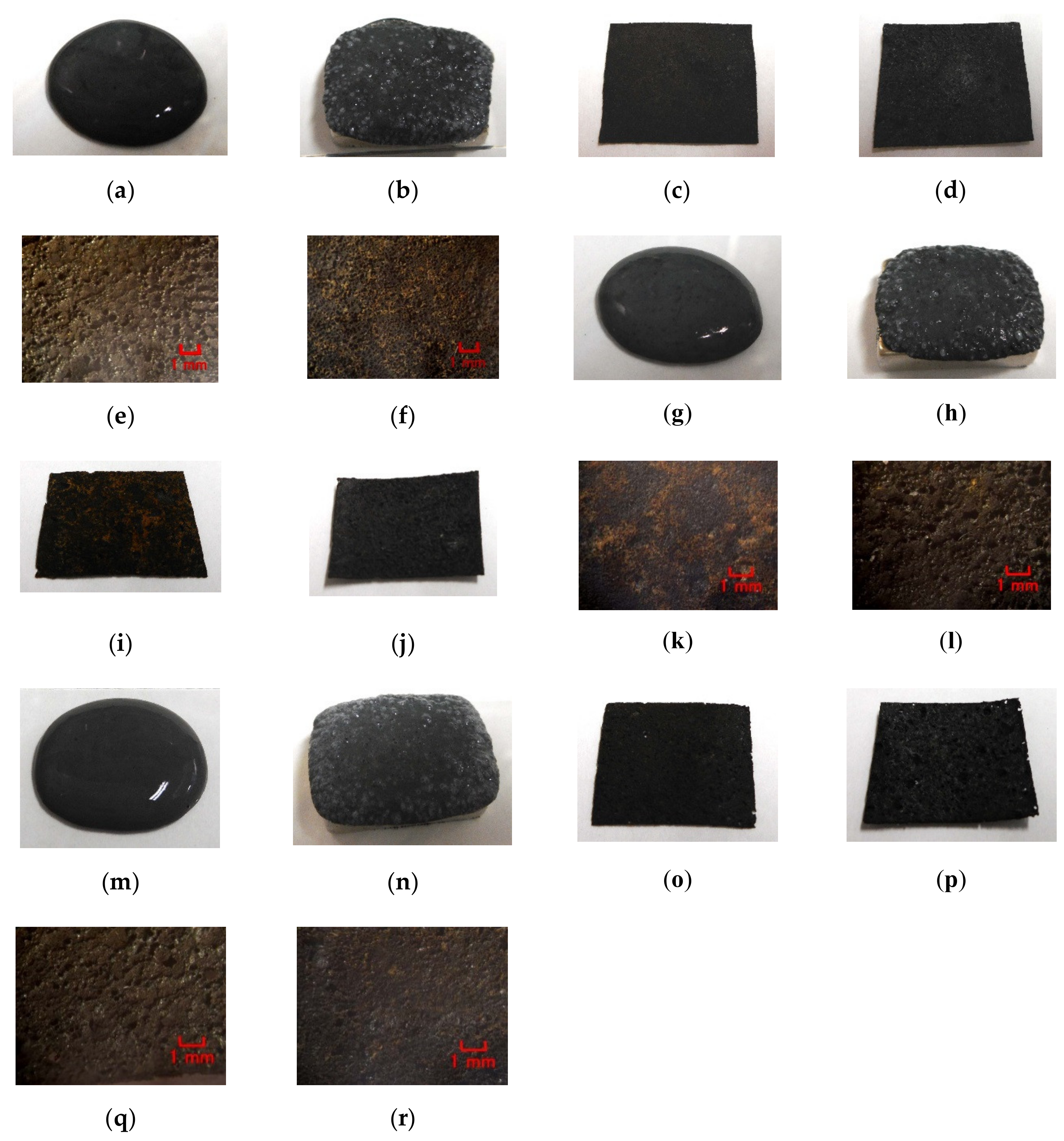
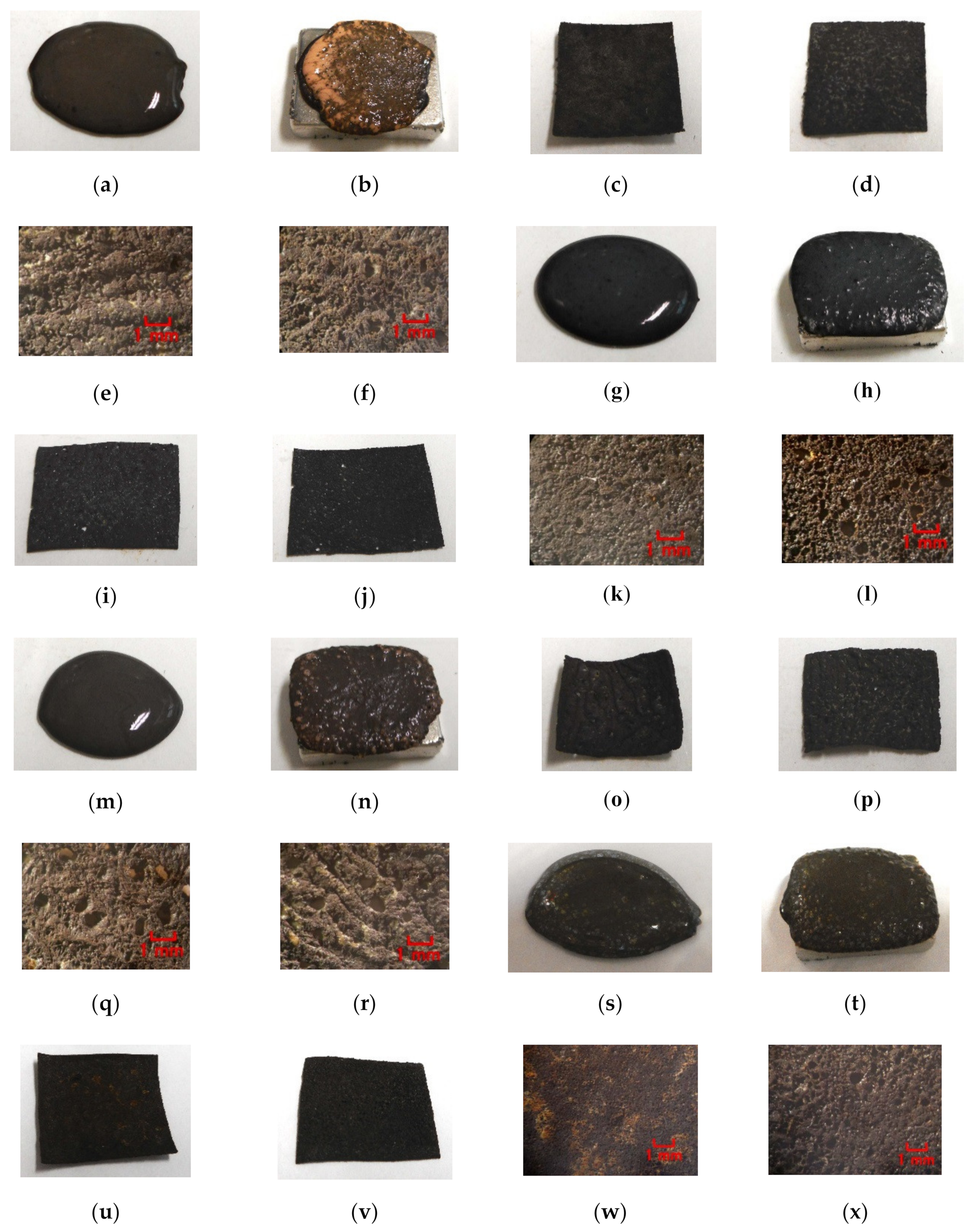
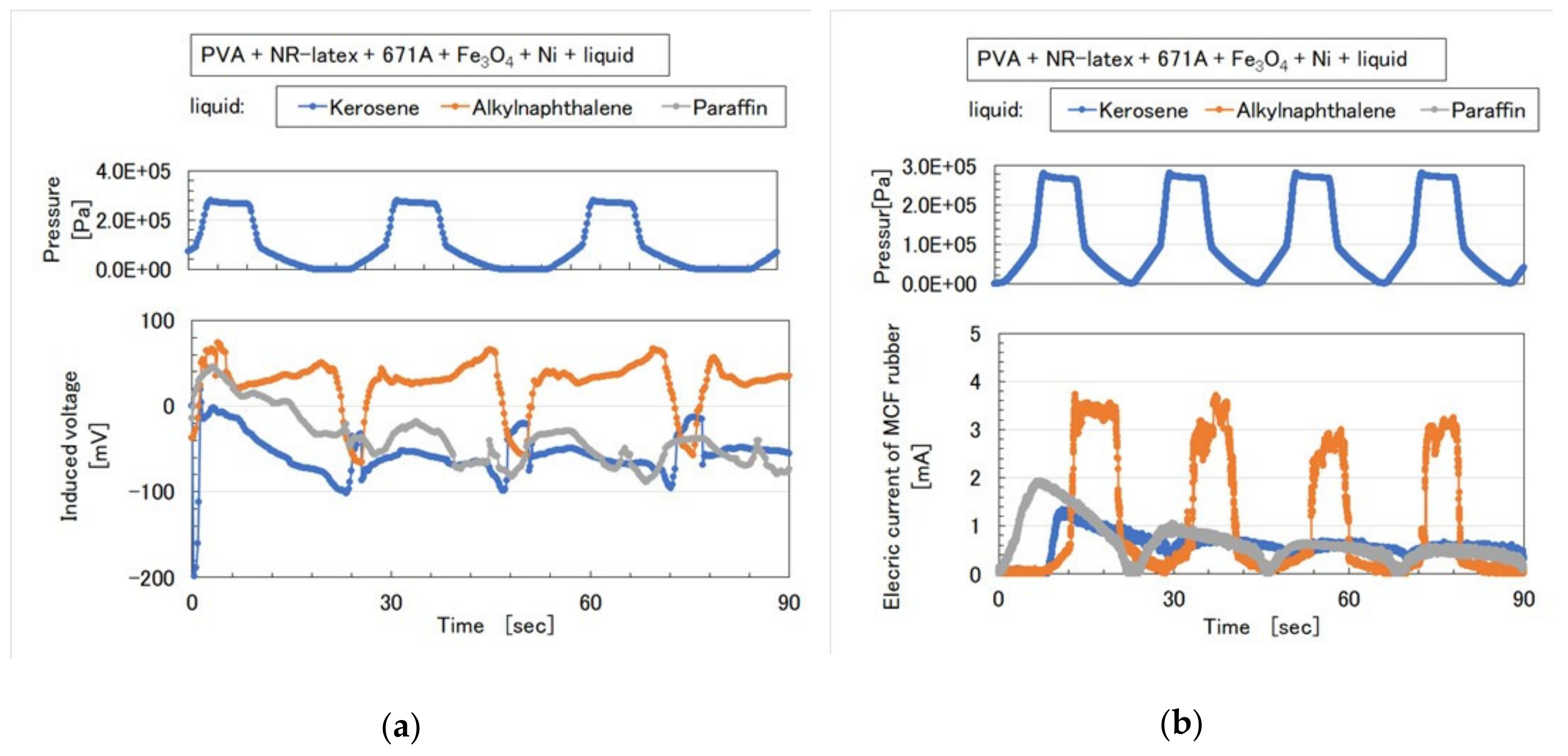

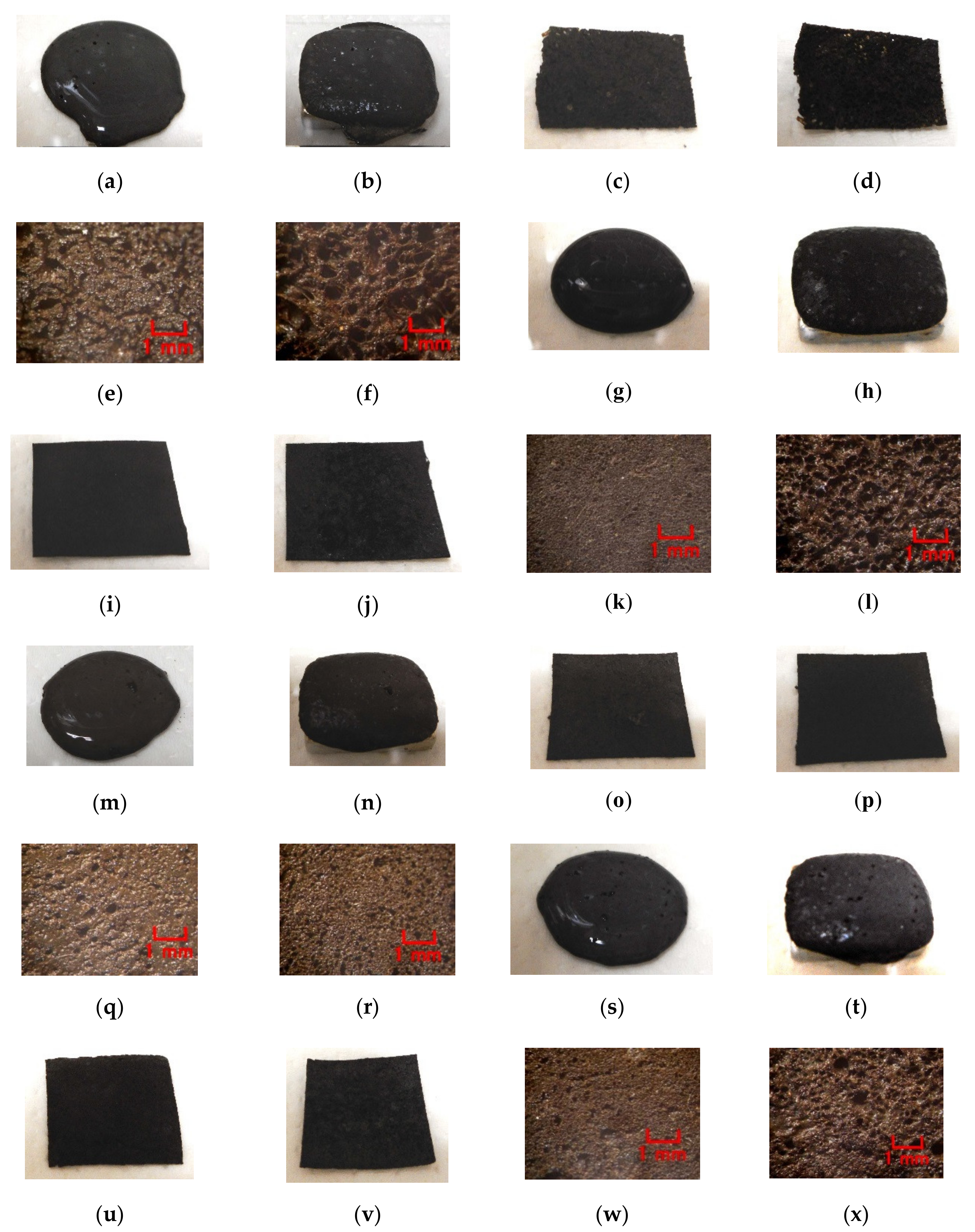
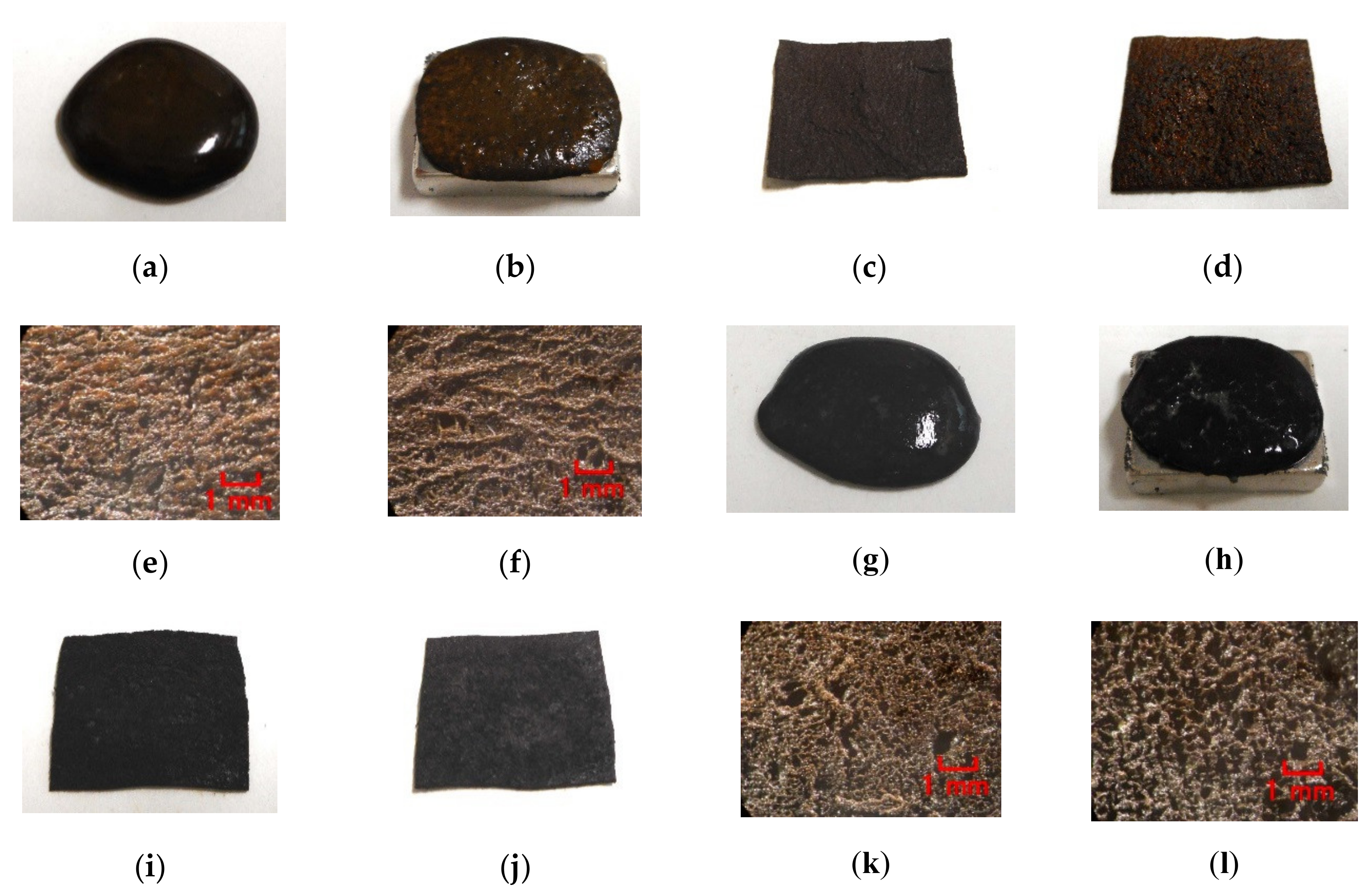
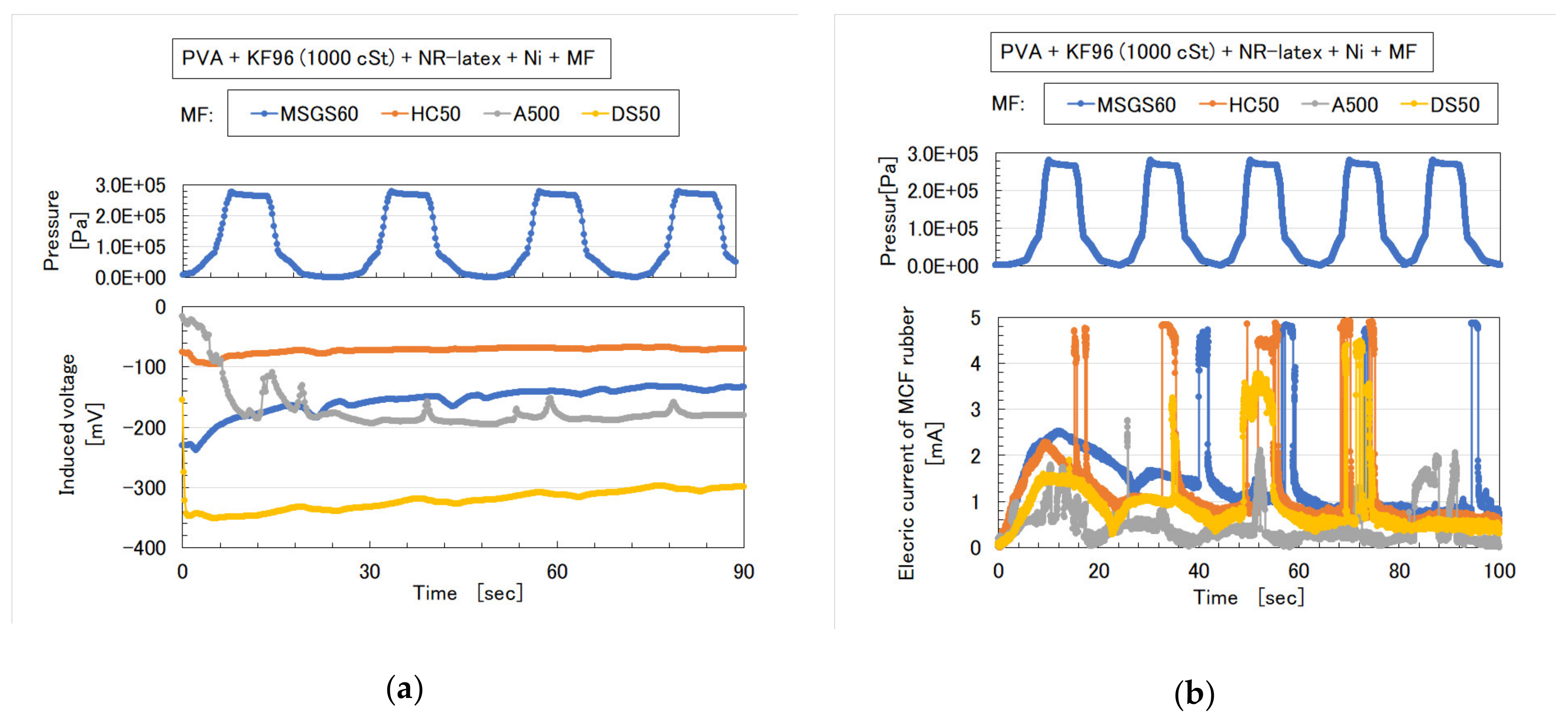


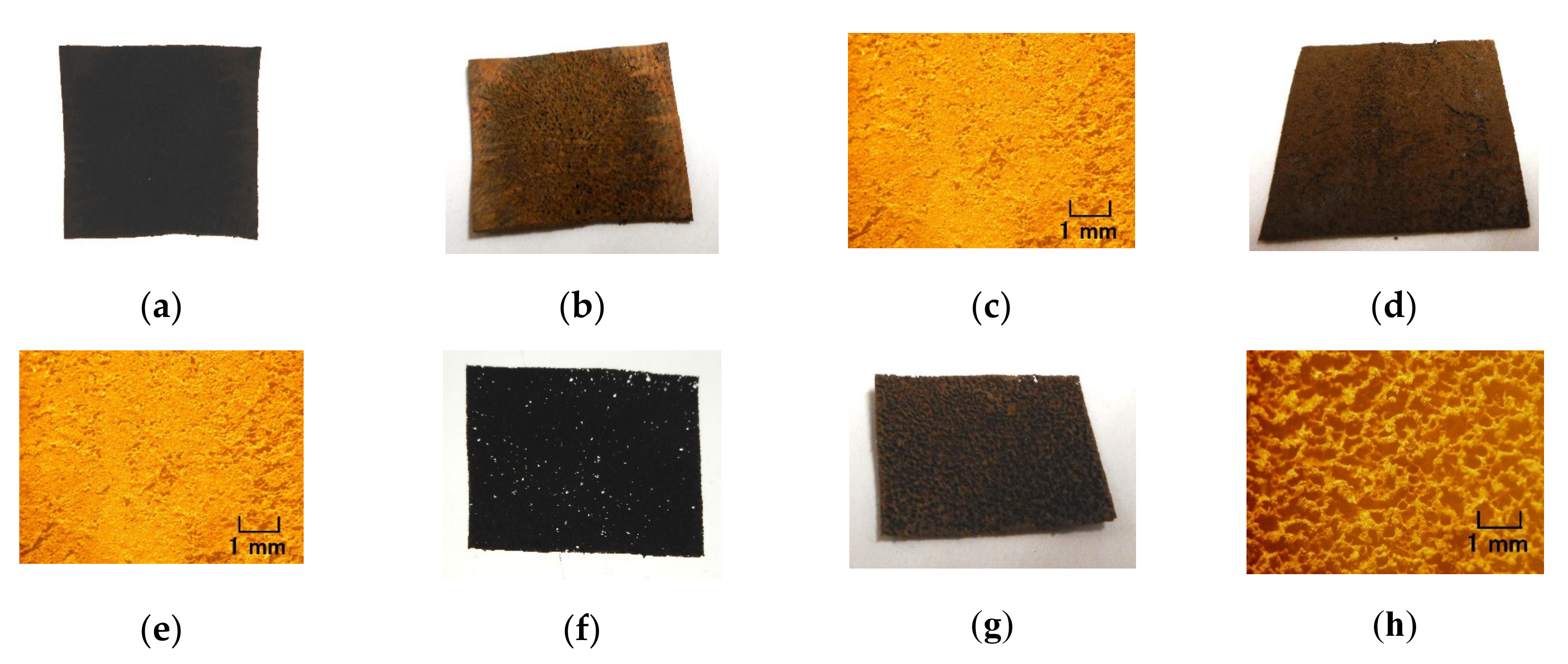
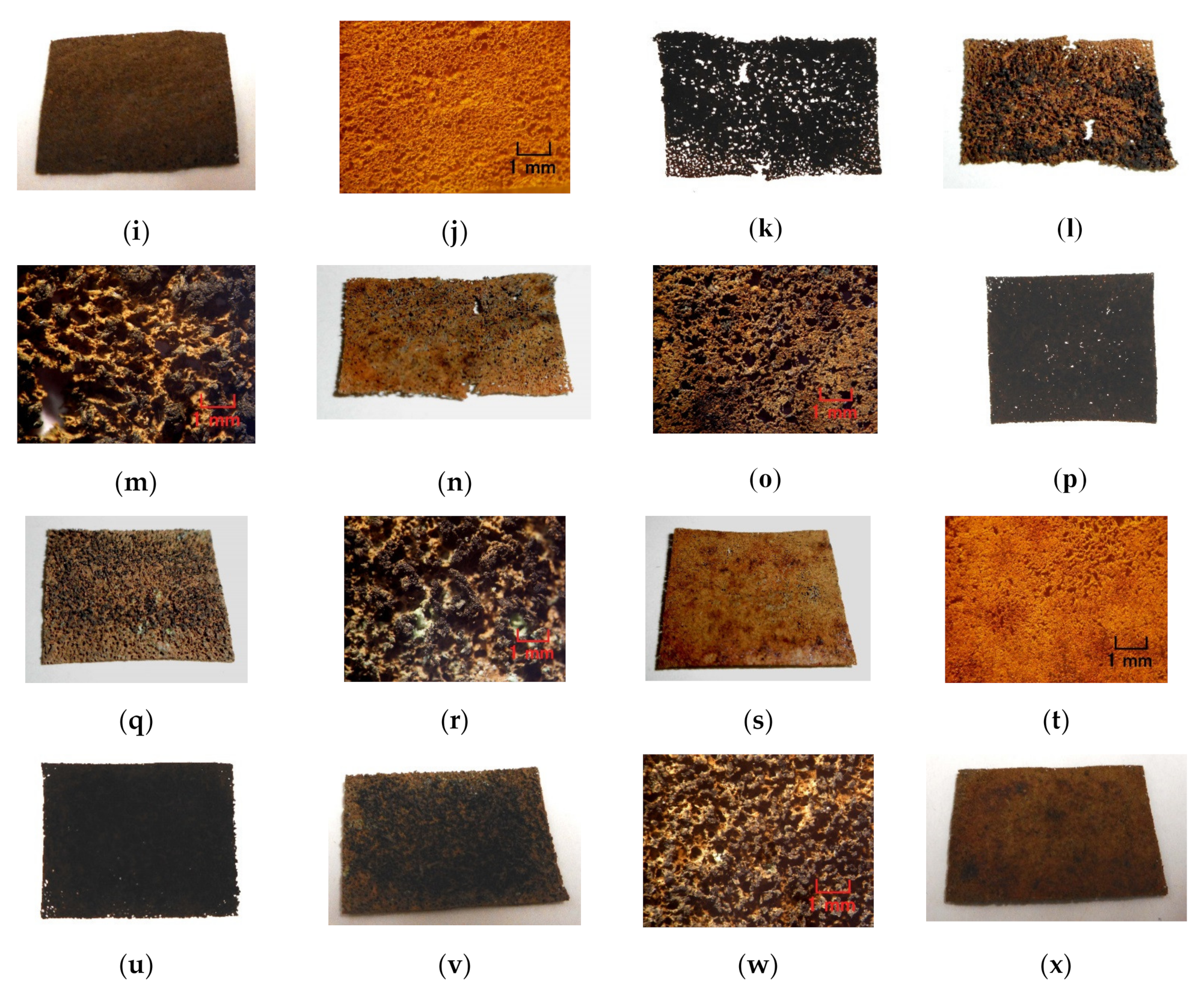
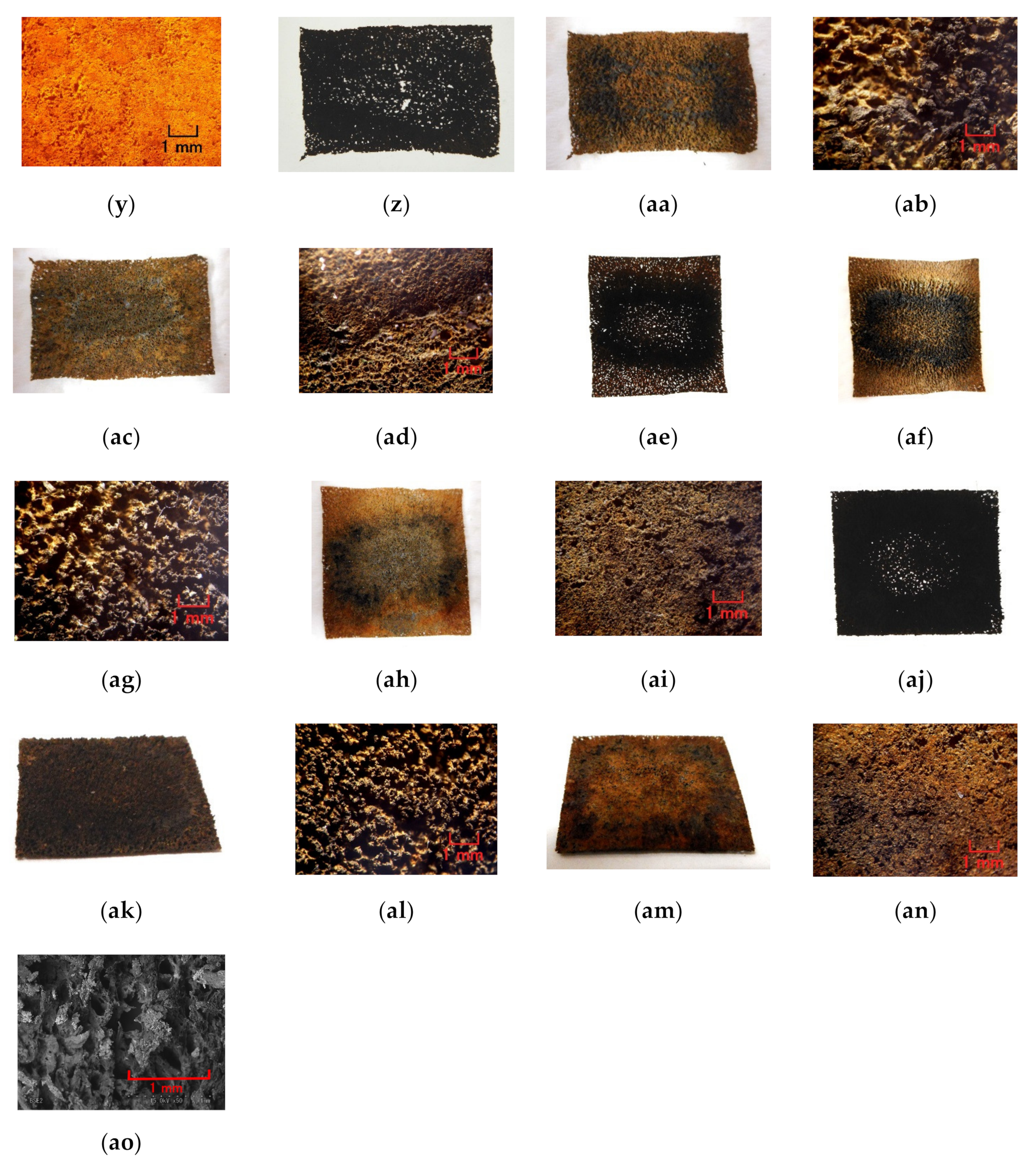

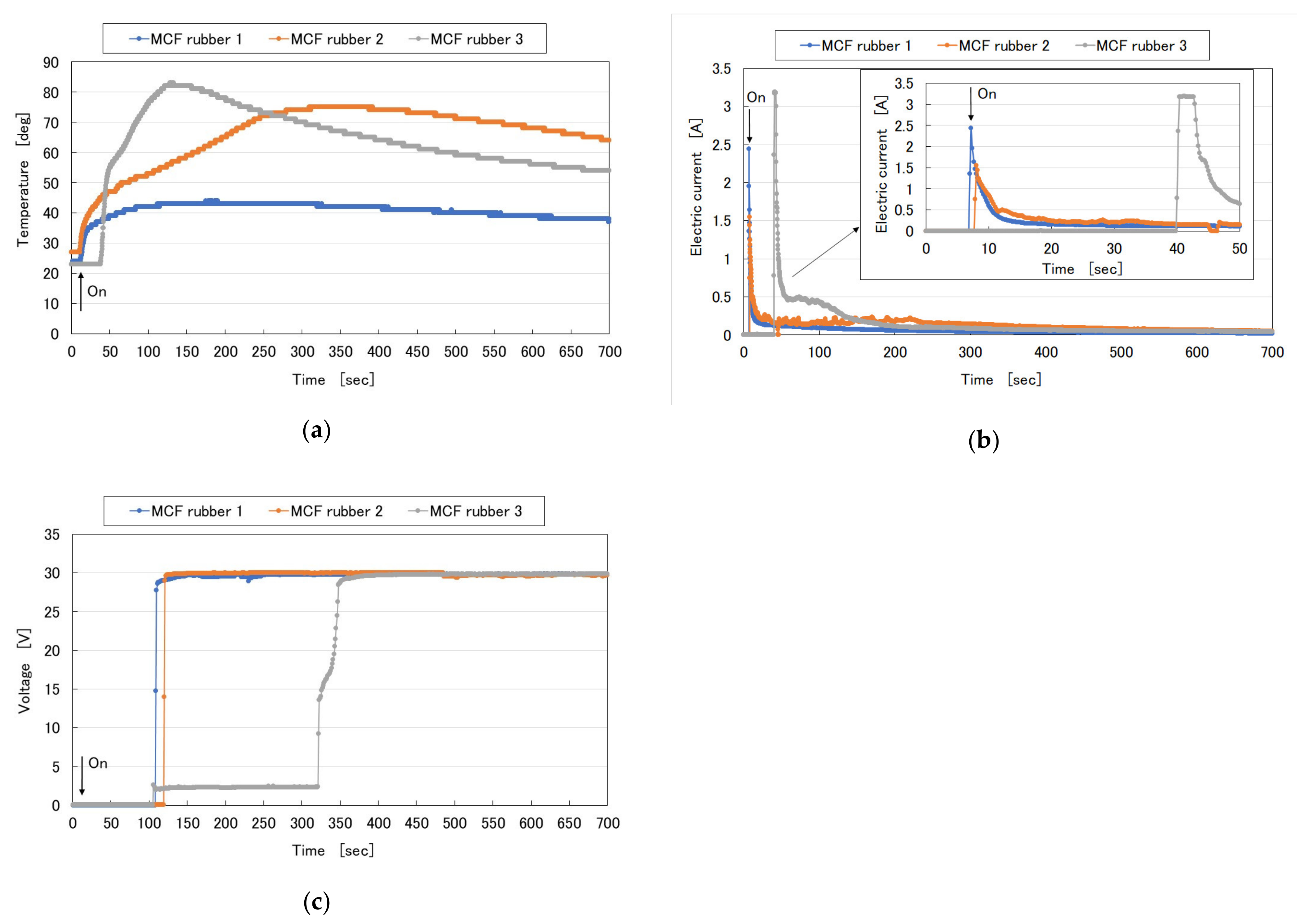
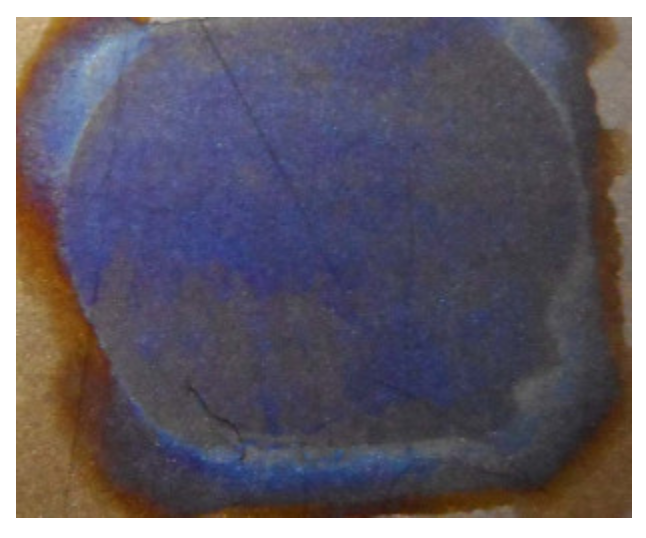
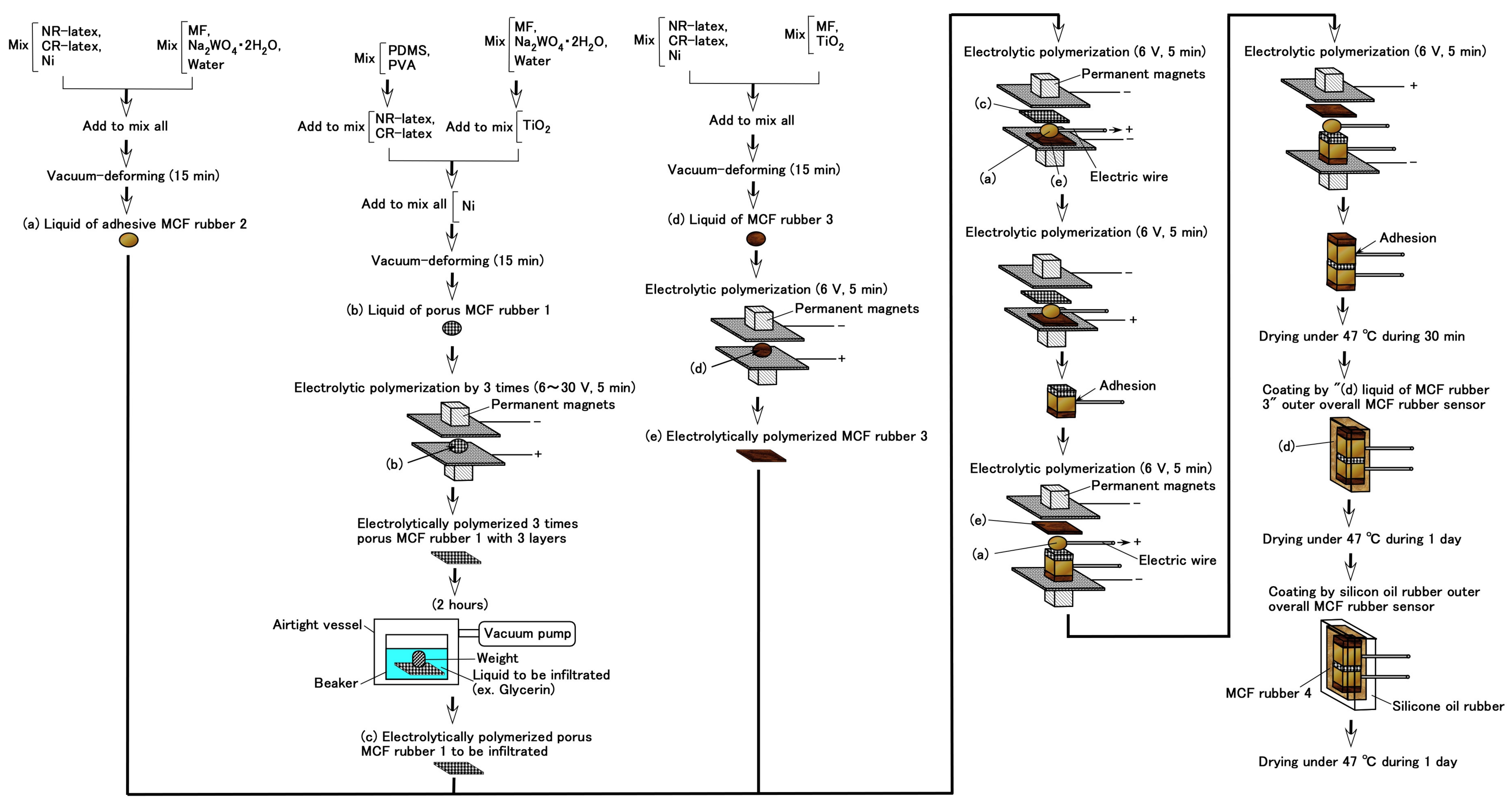

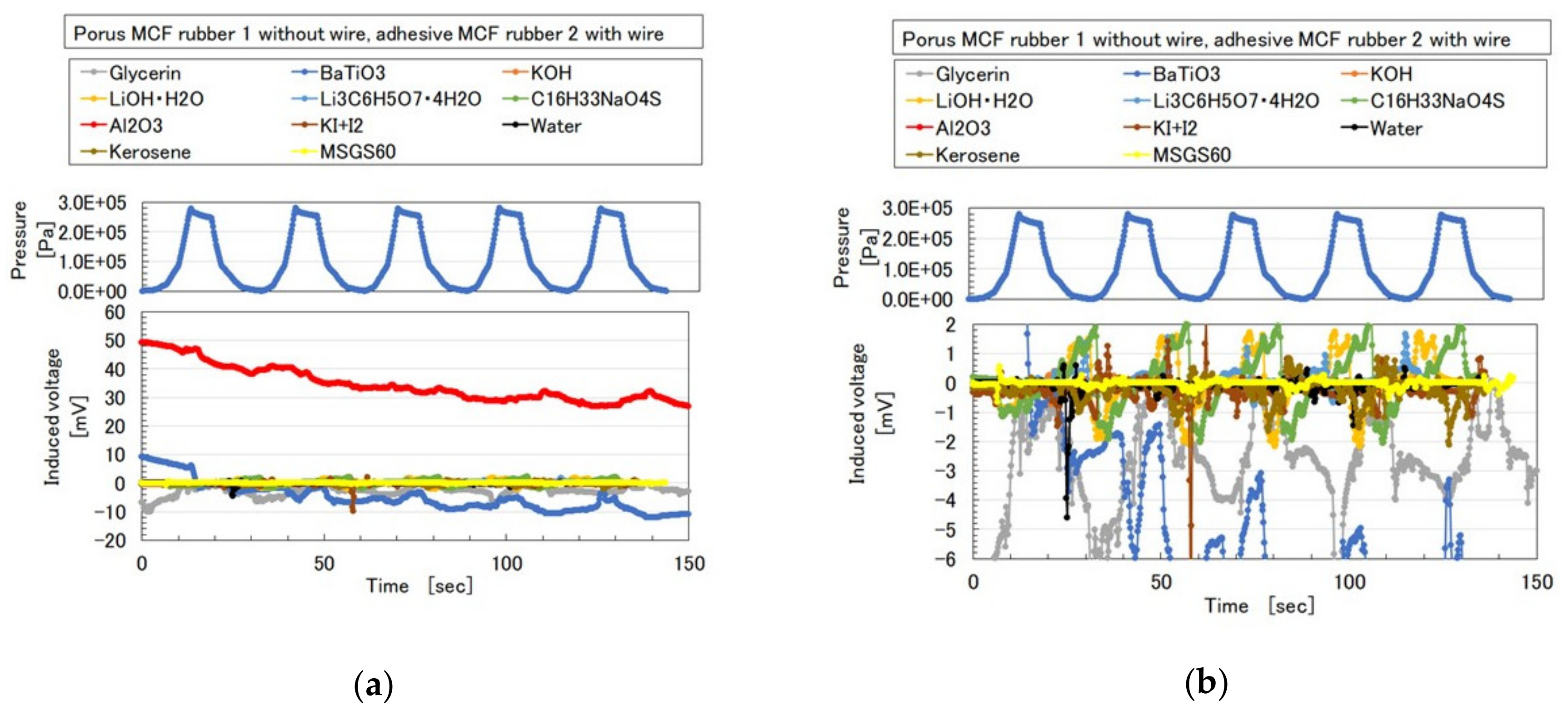
| Surfactant | Two types of Mixing | Mixing + KE1300T | Mixing + KE1400 | Mixing + KF96 (1000 cSt) | Mixing + KF96 (1 cSt) |
|---|---|---|---|---|---|
| Sodium oleate solution 3 | + NR-latex | ✕ 1 | ✕ | ◯ 2 | ◯ |
| + NR-latex, MF | ✕ | ✕ | ◯ | ◯ | |
| Sodium lauric solution 3 | + NR-latex | ✕ | ✕ | ◯ | ◯ |
| + NR-latex, MF | ✕ | ✕ | ◯ | ◯ | |
| Sodium naphthalene sulfonate solution 3 | + NR-latex | ✕ | ✕ | ✕ | ◯ |
| + NR-latex, MF | ✕ | ✕ | ✕ | ✕ | |
| Sodium hexadesyl sulfate solution 3 | + NR-latex | ✕ | ✕ | ◯ | ◯ |
| + NR-latex, MF | ✕ | ✕ | ◯ | ✕ | |
| Sodium dodesyl sulfate solution 3 | + NR-latex | ✕ | ✕ | ◯ | ◯ |
| + NR-latex, MF | ✕ | ✕ | ◯ | ◯ | |
| Tetramethylammonium hydroxy solution 4 | + NR-latex | ✕ | ✕ | ✕ | ✕ |
| + NR-latex, MF | ◯ | ✕ | ◯ | ✕ | |
| Benzethonium chloride 4 | + NR-latex | ✕ | ✕ | ◯ | ✕ |
| + NR-latex, MF | ✕ | ✕ | ✕ | ✕ | |
| Methylammonium chloride solution 4 | + NR-latex | ✕ | ✕ | ✕ | ✕ |
| + NR-latex, MF | ✕ | ✕ | ◯ | ✕ | |
| Glycerol monostearic acid solution 5 | + NR-latex | ◯ | ✕ | ◯ | ◯ |
| + NR-latex, MF | ✕ | ✕ | ◯ | ||
| Lauryl dimethylamylacetic acid solution 6 | + NR-latex | ✕ | ✕ | ◯ | ◯ |
| + NR-latex, MF | ✕ | ✕ | ◯ | ◯ | |
| N,N-dimethyldesylamine N-oxide solution 6 | + NR-latex | ✕ | ✕ | ◯ | ◯ |
| + NR-latex, MF | ✕ | ✕ | ◯ | ◯ |
| NR-Latex [g] | 671A [g] | KF96 [g] | PVA [g] | MF [g] | Ni [g] | TiO2 [g] | Voltage [V] | Dopant [g] | Na2WO4·2H2O [g] | Rubber 1 | Color 2 |
|---|---|---|---|---|---|---|---|---|---|---|---|
| 3 | 0.75 | 3 | 6 | S 4 | NC 7 | ||||||
| 3 | 0.75 | 3 | 0.5 | 6 | S 4 | NC 7 | |||||
| 3 | 3 | 3 | 3 | 0.75 | 3 | 6 | N 5 | NC 7 | |||
| 3 | 3 | 3 | 3 | 0.75 | 3 | 20.30 | PS 6 | P 8 | |||
| 3 | 3 | 3 | 3 | 0.75 | 3 | 30 | Dye 3 | S 4 | P 8 | ||
| 3 | 3 | 3 | 3 | 0.75 | 3 | 0.5 | 6 | N 5 | NC 7 | ||
| 3 | 3 | 3 | 3 | 0.75 | 3 | 0.5 | 20 | N 5 | P 8, 9 | ||
| 3 | 3 | 3 | 3 | 0.75 | 3 | 0.5 | 30 | PS 6 | P 8 | ||
| 3 | 3 | 3 | 3 | 0.75 | 3 | 0.5 | 30 | Dye 3 | S 4 | P 8 | |
| 3 | 3 | 3 | 3 | 0.75 | 3 | 30 | Dye 3 | S 4 | P 8 | ||
| 3 | 3 | 3 | 3 | 0.75 | 3 | 6 | 0.5 | N 5 | NC 7 | ||
| 3 | 3 | 3 | 3 | 0.75 | 3 | 30 | 0.5 | PS 6 | P 8 | ||
| 3 | 3 | 3 | 3 | 0.75 | 3 | 0.5 | 6 | 0.5 | N 5 | NC 7 | |
| 3 | 3 | 3 | 3 | 0.75 | 3 | 0.5 | 30 | 0.5 | PS 6 | P 8 |
© 2020 by the authors. Licensee MDPI, Basel, Switzerland. This article is an open access article distributed under the terms and conditions of the Creative Commons Attribution (CC BY) license (http://creativecommons.org/licenses/by/4.0/).
Share and Cite
Shimada, K.; Ikeda, R.; Kikura, H.; Takahashi, H. Enhancement of Diversity in Production and Application Utilizing Electrolytically Polymerized Rubber Sensors with MCF: 1st Report on Consummate Fabrication Combining Varied Kinds of Constituents with Porous Permeant Stocking-Like Rubber. Sensors 2020, 20, 4658. https://doi.org/10.3390/s20174658
Shimada K, Ikeda R, Kikura H, Takahashi H. Enhancement of Diversity in Production and Application Utilizing Electrolytically Polymerized Rubber Sensors with MCF: 1st Report on Consummate Fabrication Combining Varied Kinds of Constituents with Porous Permeant Stocking-Like Rubber. Sensors. 2020; 20(17):4658. https://doi.org/10.3390/s20174658
Chicago/Turabian StyleShimada, Kunio, Ryo Ikeda, Hiroshige Kikura, and Hideharu Takahashi. 2020. "Enhancement of Diversity in Production and Application Utilizing Electrolytically Polymerized Rubber Sensors with MCF: 1st Report on Consummate Fabrication Combining Varied Kinds of Constituents with Porous Permeant Stocking-Like Rubber" Sensors 20, no. 17: 4658. https://doi.org/10.3390/s20174658
APA StyleShimada, K., Ikeda, R., Kikura, H., & Takahashi, H. (2020). Enhancement of Diversity in Production and Application Utilizing Electrolytically Polymerized Rubber Sensors with MCF: 1st Report on Consummate Fabrication Combining Varied Kinds of Constituents with Porous Permeant Stocking-Like Rubber. Sensors, 20(17), 4658. https://doi.org/10.3390/s20174658





